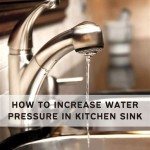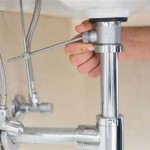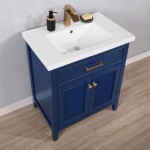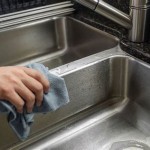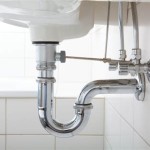How To Unclog The Kitchen Sink Naturally
A clogged kitchen sink is a common household plumbing issue, often caused by a buildup of grease, food particles, and soap residue. While chemical drain cleaners offer a quick fix, they can damage pipes over time and are harmful to the environment. Fortunately, several natural methods can effectively unclog a kitchen sink without resorting to harsh chemicals.
Boiling Water
One of the simplest and most effective methods for unclogging a kitchen sink is using boiling water. The high temperature of boiling water can melt solidified grease and soap, allowing them to flow down the drain. This method works best on clogs caused primarily by grease buildup.
To use this method, boil a kettle or pot of water. Carefully pour the boiling water directly down the drain opening. If the water begins to drain slowly, wait a few minutes for the heat to work on the clog, then pour another kettle of boiling water down the drain. Repeat this process until the water flows freely.
Baking Soda and Vinegar
The combination of baking soda and vinegar creates a fizzing chemical reaction that can help break down clogs in kitchen sinks. This method is effective for removing grease, food particles, and other organic matter.
First, pour one cup of baking soda down the drain. Follow this with one cup of white vinegar. The mixture will immediately begin to fizz. Cover the drain opening with a stopper or plug to contain the reaction within the drainpipe. Let the mixture sit for 30 minutes to an hour. After the waiting period, flush the drain with hot water to clear away the loosened clog.
Salt and Baking Soda
Similar to the baking soda and vinegar method, salt and baking soda can also create a chemical reaction that breaks down clogs. This method is particularly effective on stubborn clogs.
Mix one cup of baking soda with half a cup of salt. Pour this mixture down the drain, followed by a pot of boiling water. Let the mixture sit for several hours, or preferably overnight. In the morning, flush the drain with hot water. The combination of the salt, baking soda, and hot water should dislodge the clog.
Plunger
A plunger can be a highly effective tool for unclogging a kitchen sink. It creates suction and pressure within the drainpipe, forcing the clog to dislodge and move down the drain.
Before using a plunger, seal any overflow drains with a wet cloth or stopper. Fill the sink basin with enough water to cover the cup of the plunger. Place the plunger over the drain opening, ensuring a good seal. Push and pull the plunger up and down vigorously for several minutes. Remove the plunger and check if the water drains freely. Repeat the process if necessary.
Plumbing Snake
For more stubborn clogs that resist other methods, a plumbing snake can be used to physically break up or retrieve the blockage. A plumbing snake is a flexible metal cable that can be inserted into the drainpipe.
Insert the end of the plumbing snake into the drain opening. Rotate the handle as you push the snake further into the drainpipe. Once you feel resistance, continue rotating the snake to break up the clog or to hook and pull it out. Retrieve the snake and flush the drain with hot water to clear away any remaining debris.
Prevention
Preventing clogs is always preferable to dealing with them after they occur. Some simple preventative measures can significantly reduce the likelihood of kitchen sink clogs.
Avoid pouring grease down the drain. Instead, collect grease in a container and dispose of it in the trash. Use a strainer to catch food particles and other debris before they enter the drain. Regularly flush the drain with hot water, especially after washing greasy dishes. These simple steps can help keep your kitchen sink draining freely and prevent future clogs.
Regular Maintenance
In addition to preventative measures, performing regular maintenance can also help keep your kitchen sink clog-free. This can include periodically using one of the natural cleaning methods described above, even when the sink isn't clogged.
For instance, flushing the drain with boiling water once a week can help prevent grease buildup. Similarly, using the baking soda and vinegar mixture monthly can help keep the drain clean and clear. This regular maintenance can prevent minor clogs from developing into larger, more stubborn blockages.
Understanding Your Plumbing
Knowing the layout of your plumbing can be helpful in unclogging your kitchen sink. Understanding where the pipes run and where traps are located can inform your approach to unclogging.
For example, if you know there's a P-trap under your sink, you might be able to directly access and clean it, removing the source of the clog. While some plumbing knowledge can be beneficial, it's crucial to avoid undertaking complex plumbing tasks if you're not experienced. In such cases, it's always best to contact a professional plumber.

How To Unclog A Kitchen Sink Using Baking Soda And Vinegar

How To Unclog A Sink 5 Natural Easy Ways Kitchen Cabinet Kings

How To Unclog A Sink The Experts Simple Steps Drain

How To Unclog A Kitchen Sink Drain

How To Unclog A Sink Herrmann Services

How To Unclog A Kitchen Sink Drain By Home Repair Tutor

How To Unclog Your Kitchen Sink With Baking Soda And Vinegar It Works

How To Unclog A Sink 5 Natural Easy Ways Kitchen Cabinet Kings

3 Ways To Unclog A Sink Naturally Wikihow Life
How To Unclog A Sink 4 Easy Ways
